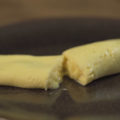Last time we talked about the basics of buying a knife so it is only natural that we go over how to keep that knife sharp or how to sharpen a knife. While it seems backwards, a dull knife is more dangerous than a sharp one, since it’s less predictable and even if it can’t slice through a tomato it can still cut you!
There’s many ways to sharpen a knife, you can get them professionally sharpened at your local knife shop, use an electronic or manual sharpener, or my personal favorite method; using whetstones! I want to go over the differences between these methods and some basic guidelines to help you sharpen your knives with a whetstone.
Sharpening Methods
Honing Rod or Sharpening Steel
First, you might think using a sharpening steel will sharpen your knife but despite its name it actually does not sharpen but rather, it hones your knife by realigning the edge to be sharp again. This is useful if your knife is only slightly dull or needs a little refresher before starting your day at work.
Get Your Knife Professionally Sharpened
The next method is getting your knives professionally sharpened. It’s a great way to get to know your local knife shop as they tend to hold events for new products or even learning seminars. Getting your knife sharpened by professionals means you’ll get back a very sharp knife and while it may seem like a luxury, most home cooks will only need their knives sharpened a couple times a year. Here in the Bay Area we know that Bernal Cutlery in San Francisco and Perfect Edge in San Mateo offer sharpening services.
DIY Knife Sharpening: Electric Sharpeners
A popular choice for home cooks is sharpening it with an electric or manual sharpener. They are extremely easy to use: you just run your knife through the correct slots. My issue with some of these is that I feel they take too much steel off your knife, which would shorten the life of it. I haven’t used one of these for years but am aware they make better ones now. The thing to keep in mind is they won’t really work on knives with a full bolster (handle) and they can run a bit expensive, at least the good ones. If you do go this route or already have one, make sure to follow the directions of whatever sharpener you choose. Out of all the methods, this one would be on the bottom of my list.

DIY Knife Sharpening: Whetstones
Finally, my favorite way of sharpening a knife is with whetstones. The process is soothing and meditative for me now, but the con with whetstones is that it does take some time to master or get comfortable at it. Most find it difficult to keep the correct angle to sharpen the knife, but you can use it to sharpen a knife with any blade angle from single or double bevel, 50-50, 70-30 – whatever! When I first started, I was super overwhelmed, but over time I found the right grit combination for my knives. When you first start off, practice on a knife you don’t care about until you get the feel for it.
Whetstones Basics
Here’s a few things to know about whetstones before we get into how to use them. Whetstones come in different grit levels:
- Coarse stones range from 100 to 700 and would be used to restore damaged, chipped or nicked knives, and incredibly dull knives.
- Medium stones range from 800-3000 grit and around 1000 is considered the go to grit level to use if your knives have lost their edge.
- Finishing or polishing stones which range from 4000 to really high but you wouldn’t need anything over 8000, if that!
Some stones need to soak in water while others are called “splash-n-go”.
Sharpening Basics
You’ll need a few other things for sharpening like a sort of stone holder like a sink bridge or just use a brick with a rubber liner as I do, so the stones don’t move around while sharpening. The brick gives me extra elevation so my fingers are clear from any obstruction and I also like to place on a small sheet pan to catch any drippings of water. You’ll want a container with water handy and also a towel or two.
When sharpening with a whetstone, keeping a consistent angle is the most important factor. If you are just starting out, you may prefer to use an angle guide to help you keep the correct angle. There is even a way to use a sharpie to help you sharpen at the right angle for your knife. My way of finding the correct angle is to lay the blade flat on the stone and then tilt the spine side of the knife up until you can feel when the edge of the knife is flush to the stone. This will help you sharpen at the correct angle for that specific knife as each knife has a different angle to their blade, which can range from 9.5 to 15 degrees!

How to Sharpen a Knife with a Whetstone
Now that you know what you need for sharpening your knives with the stone, let’s go over how to. Generally, if you know the mechanics of the process, then you can start to play around with the grit combinations that suit you. We’ll start with sharpening a very dull knife with a coarse stone of 300 grit.
The Grip:
I find that using a pinch grip with your finger at the top is the most comfortable way for me to keep my wrist stable or less likely to move and change the angle. Find the correct angle by any methods that works for you and do your best to keep it consistent.
Safety Tips: Keep the fingers away from the edge as it’s possible to get pinched between the stone and edge causing you to lose some fingerprints. Another thing that can happen is if the non-active fingers (of your pressure hand) are below the edge and the knife slips off the stone you may end up with a shorter finger.
The Pressure and Motion:
The pressure when sharpening comes from your fingers that are placed on the blade. You always want to put pressure in the direction that is away from the cutting edge, if it’s your first go at it and you are still uncomfortable then push with 4-6 pounds of pressure, if you have a scale press on it to get a feel for that range. Once you have pushed to the end of the stone, lift the knife and bring it back to the starting point. When you start to get used to it you’ll be able to go a little faster, releasing pressure on the way back to the starting point.
The Stroke
You’ll see many ways of sharpening a knife with a stone, but the stroke is entirely preference. One way is to perform smooth long strokes from tip to butt end of the knife. Others like to split the knife into sections, which is the way I like to do it.
The Tip
A tip for the tip: start with a slightly lifted handle of a 45 degree lift and as you push, lower to the proper angle of the knife as you follow the curve of the tip.
The Burr
Check if you have created a burr, which is when the knife edge curls towards one side creating somewhat of a lip. You can feel this by running your thumb at the edge of the knife perpendicular to the edge and if there is a burr, then it will feel like a little scratch on your thumb or like the edge is catching your thumb. Once you’ve got a burr then we can then switch over to the other side.
The Switch
You can either switch hands or you can use the same hand and turn the blade over. Again, concentrate on keeping that angle as best as you can. The only awkward part of using the same hand is sharpening the butt end. If the knife allows you to sharpen straight across stone then great, but for some reason if the handle or something is in the way then I find that pointing the knife 45 degree towards you helps with sharpening the butt end.
The Rest of the Process
After you have created a burr on the second side then you are finished with this stone. De-burr the knife by performing long smooth strokes alternating each side. Now you can switch to your medium stone. The process with this stone is exactly the same as the previous stone. Once that is done you are ready for the finishing stone
The Finishing Stone
The final stone is practically the same process as the other two stones but with much less pressure with this stone. You no longer need to remove metal to create an edge, rather, you are polishing the edge for looks and a bit of sharpness.
If it’s your first time then take your time! If it’s hard to keep the angle, try using smaller strokes. If you are sharpening a butcher knife or a knife that cuts mostly meats, you do not have to go higher than 4000 grit. I like to stop my all purpose knives at 6000 and knives that mostly cut veggies or fruits at 8000 grit. You can test how sharp your knife is by cutting paper or a tomato.
To maintain your whetstones you’ll need a flattening stone and a pencil. Simply draw some lines across your whetstone and go at it with the flattening stone until all the pencil marks are gone. This will keep your sharpening much more efficient. After, make sure to clean with water and let it air dry.
I know it’s hard to imagine the whole process with just words so I hope the video helps give you a better visual. If you made it this far, I appreciate you and hope you can share your sharpening journey with us with a comment or a message on our home base, Cene. Until next time, stay sharp!






Thanks for explaining that the angle is also an essential part of knife sharpening. I’m interested in looking for mail-in cutlery knife sharpening services because I recently bought a new dinner plate set. I might need to have my old steak knives sharpened to supplement that purchase.
Hi Alice, glad you found our guide helpful! We have not tried any mail-in sharpening services and so cannot recommend any. We’d love to know how your experience goes, so please keep us posted!